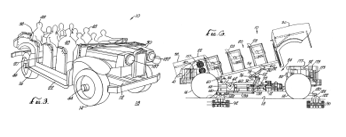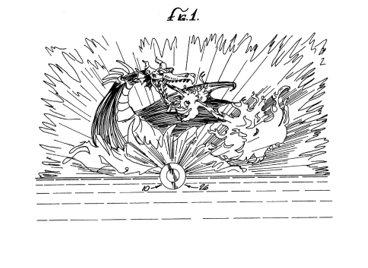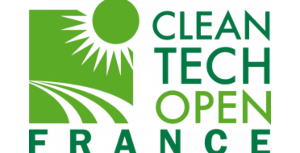As the summer holidays have begun, many of you, both young and old, will likely visit a theme park to experience unique and unforgettable moments. But do you know how Industrial Property has contributed to revolutionizing the attractions found there? Let me take you through the secrets of patents and designs that have led to the success of one of the most creative minds of the 20th century.
You guessed it, we're talking about the parks of The Walt Disney Company, the global company that owns five Resorts (Disneyland Resort & Disney California Adventure, Walt Disney World in Florida, Disneyland Paris & Walt Disney Studios, Hong Kong Disneyland, and Shanghai Disneyland) and manages Tokyo Disneyland & Tokyo Disney Sea on behalf of the Oriental Land Company. In this article, I hope to show you your favorite attractions from a different perspective.
Enhancing the Audiovisual Experience
 |
Walt Disney was, above all, a genius creative. With his team of Imagineers (a contraction of Imagination and Engineers), he invented the multiplane camera used to create a unique depth effect in animated films in the 1940s. Here's an image from one of the patents filed in 1938 on the subject. The device measures nearly 4 meters high. Impressive, isn't it? |
 |
The company later filed a patent in 1960 for the "nine eyes" camera used for the Circarama attraction and then for the Visionarium (at Disneyland Paris). This device allowed a film to be projected onto a 360° screen (the "Circle Vision") using nine synchronized projectors, a very avant-garde technology for the time. |
Immersing Visitors in the World of Heroes
When Walt Disney started taking an interest in theme parks, he wanted to do more than "sit on a bench eating peanuts while watching his two daughters play on a carousel." He wanted to create a park where children and parents could have fun together. Thus was born the first park, opened in 1955 in Anaheim, California, the famous Disneyland.
Early on, Walt Disney worked with his team of Imagineers to create attractions for this first park. Naturally, he protected certain technologies that became timeless successes over time and are still in use today. We must also acknowledge Walt Disney's undeniable talent for continuously imagining the future, such as his project for a city of tomorrow called "Experimental Prototype Community of Tomorrow," which became EPCOT theme park, opened in Florida in 1982 as a tribute to knowledge.
 |
Here is the first Audio-Animatronic (another "portmanteau" word mixing Animation and Electronic). This bird, present in the Tiki Birds attraction, was initially presented at the 1964 New York World's Fair. But what does this bird do? Well, it moves, albeit still somewhat jerkily, but most importantly, it "talks." Its beak moves in sync with its "words" thanks to a system patented in 1960 by WED (Walter Elias Disney was his real name). |
 |
These automatons truly revolutionized attractions. There is another more recent patent (US2012152051) for an improved version used in the Beauty and the Beast attraction at Tokyo Disneyland. Isn't our dear "Lumière" realistic? |
Today, state-of-the-art Audio-Animatronics can be found in several attractions, notably the Shaman from Nav'i River Journey at Animal Kingdom (Florida) and more recently in the new "Fantasy Springs" land opened in June 2024 at Tokyo Disney Sea and the renovation of Splash Mountain at Magic Kingdom (Florida). These automatons have highly complex movements with unprecedented fluidity and realism, thanks to electric actuators and computerized control. Over time, Disney has indeed become a true pioneer in robotics.
 |
Moving on to the WEDway People Mover, a revolutionary visitor transport system still present at Magic Kingdom in Florida. Since the late 1960s, it has used vehicles that circulate automatically on a loop without stopping, propelled by... electromagnets. |
 |
Continuing our exploration of innovative transport modes, we find the OmniMover used notably in the famous Phantom Manor attraction at Disneyland Paris (Haunted Mansion on the other side of the Atlantic). This system has vehicles (called "Doom Buggies") that rotate on themselves and circulate in a loop along a hidden rail, hence the presence of a moving walkway for getting on and off. |
 |
A more recent aquatic version ("boat ride") described in US2013025491 has been used at Shanghai Disneyland for the highly immersive Pirates of the Caribbean: Battle for the Sunken Treasure attraction.
|
 |
Walt Disney and his teams are also behind the first "roller coaster" using a round metal rail circuit welded together. This is the Matterhorn Bobsled (inspired by the Matterhorn), still active at Disneyland in California after nearly 70 years of good and loyal service. It's not the youngest, but it remains vigorous, and your vertebrae will remember it! |
 |
Who doesn't know the It’s a Small World attraction, first presented at the 1964 New York World's Fair? We won't talk about its catchy music (you're welcome!) but rather a patent describing its double dock system to speed up boat boarding and increase its capacity. |
 |
Let's change universes and see what’s happening in the world of the Force. The Star Wars universe has inspired several attractions, including Rise of the Resistance, arguably one of the best in the world, which opened in 2019 at Disney Hollywood Studios in Florida. But the subject here is Star Tours, where access between the articulated vehicles on jacks (the "Star Speeders") and the entrance/exit is via a patented walkway (EP0324567). Yes, even walkways can be innovative and patented! |
 |
Let's jump back in time and visit our dear Indiana Jones at Disneyland California and Tokyo Disneyland. As any good adventurer, Indy loves vehicles that speed over rough terrain. Let's see what the Imagineers designed in the 80s to give visitors the same sensations. The solution lies in the Enhanced Motion Vehicle (EMV) technology: the cars ("rovers") running on a rail are mounted on jacks that tilt the chassis forward, backward, and sideways, especially in turns or descents to shake visitors. This attraction is one of the most accomplished examples of Imagineering illustrated by patents US5583844 and US5623878. Note that two European patents exist… but there is still no corresponding attraction in France, unfortunately. |
 |
The creation of Disneyland Paris in the early 90s led to several innovations for attractions like Space Mountain. Another first for Disney, creating the world's first roller coaster with onboard synchronized audio. At the time, this major innovation (patent US5784473) was very complex to implement since each vehicle has its own sound system, and the train rushes at nearly 100 km/h after an inclined catapult launch (the same system as aircraft carriers, by the way).
|
 |
Since we are in the world of roller coasters, another propulsion system was patented (US5595121) for the Rock & Roller Coaster attraction. Unlike Space Mountain, this device is horizontal and uses Linear Induction Motor (LIM) technology, consisting of a series of very powerful magnets that synchronously repel a metal bar fixed under a several-ton train to propel it to 100 km/h in 28 seconds. Intense and exhilarating! |
 |
True "jack-of-all-trades," the Imagineers also worked in the early 90s on fireworks to make them not only more beautiful but also quieter and more environmentally friendly (by the standards of the time). This is illustrated by the very descriptive patent EP0620910. |
 |
Still in the 90s, Disney also focused on nighttime shows and patented (US5368228) a technology for Fantasmic, which now seems increasingly common: projecting videos onto a water screen. These floating and moving images in the air are very impressive and have fascinated many. |
Making Visitors Fly
Going beyond the immersive experience and inspired by the song "You can fly" from Peter Pan, the Imagineers once thought, "What if we made our visitors fly?" What a challenge for them to design this mobile structure carrying three rows of seats articulated in the void and placed in front of a hemispherical screen! Add to that wind and scent diffusion, and you get Soarin Over the World, a creative and sensational success. There is a French patent (FR2818916), but there is no version at Disneyland Paris yet, unfortunately…
 |
"To infinity and beyond," says Buzz Lightyear as he leaps into the void, hoping to fly (he's just a toy, but shh, don't tell him!). The different versions of the Buzz Lightyear attraction use a patented targeting system (US7955168) to shoot at targets to defeat the evil robot Zurg. Grab your pistols, but aim well! |
 |
Who hasn't dreamed while watching Avatar of riding a "Banshee," that multicolored dragon so hard to tame? The Flight of Passage attraction, opened in 2015 in the Pandora land at Animal Kingdom, allows you to achieve the impossible safely. This incredible attraction is arguably one of the most immersive in all Disney parks. Here is the technology described in US10213701 and US9744930 that keeps you snug against your mount, which "breathes" in sync with the adventure through localized inflation movements of part of the "saddle," all in front of a high-definition 3D film on a hemispherical screen. A moment both poetic and dizzying. |
 |
Since the 2000s, the company has mainly innovated in other fields: communication, multimedia content, interactivity, video games, user interfaces, virtual & augmented reality, real-time animation, digital AI, internet & cloud. Moreover, even though Disney still works a lot on mechanics (robotics), it has always relied on third-party companies like Arrow Dynamics, Intamin, and especially Vekoma since the 50s. |
The Future: “If you can Dream it, you can do it”
Now, here are some patents for attractions that have not yet seen the light of day. The developed technologies are often very innovative and will undoubtedly provide new sensations. We might be lucky enough to try them someday, who knows… And as Walt Disney said: "Just remember it all started with a mouse…"

Attraction for flying among buildings: EP2394720

Pendulum-type Roller Coaster: US10155171

Roller Coaster with tilting vehicles: EP2399657

Dumbo-type attraction with frogs: EP2418008
There’s More Than Just Patents in Parks!
Other aspects of Intellectual Property are widely used there: we could also talk about music and characters protected by copyright, the trademark licenses granted, such as those of Star Wars or Marvel characters acquired by Disney to integrate them into the parks. This could easily be the subject of a future article.
To end on a playful note, here are some registered designs of various Disneyland Paris attractions that you will undoubtedly recognize:

Sleeping Beauty Castle: DM/023902-002

Tie Fighter (Star Wars): DM/023902-006

Orbitron at Adventureland: DM/023902-003

Airship at Discoveryland: DM/023902-005

Captain America’s Shield: USD819750

Skull Rock at Adventureland: DM/023902-009













